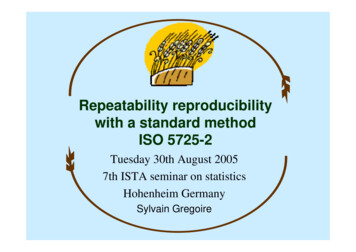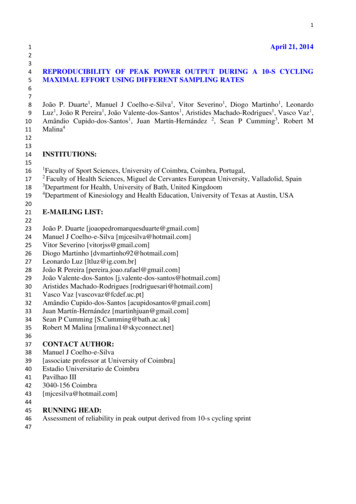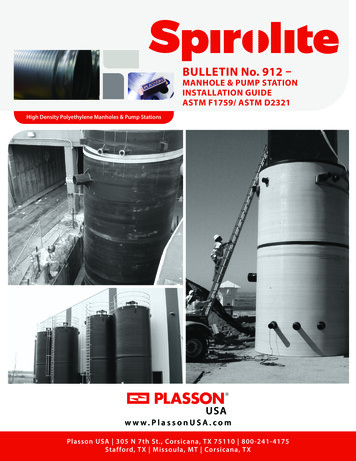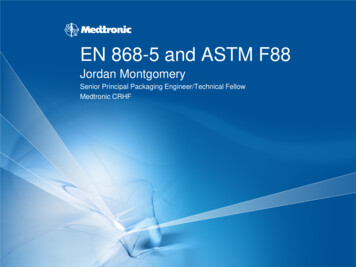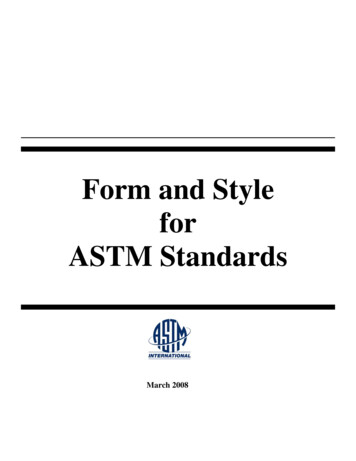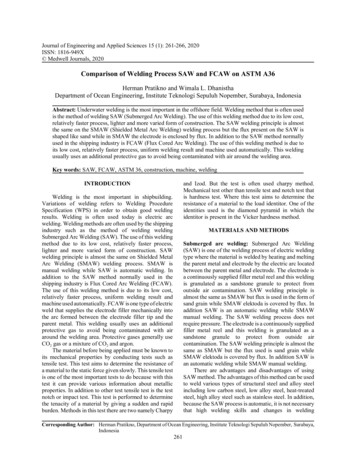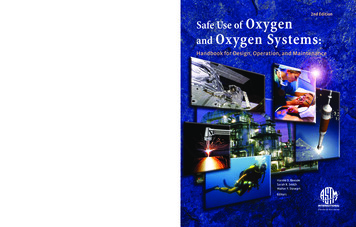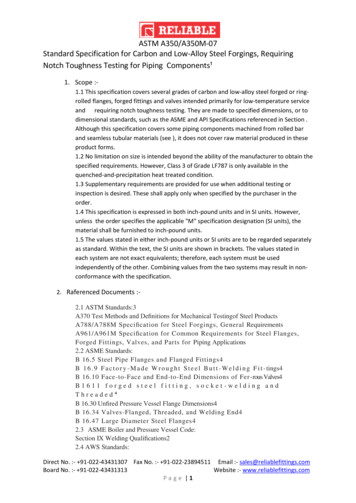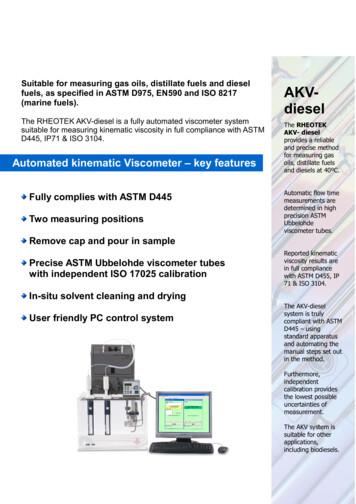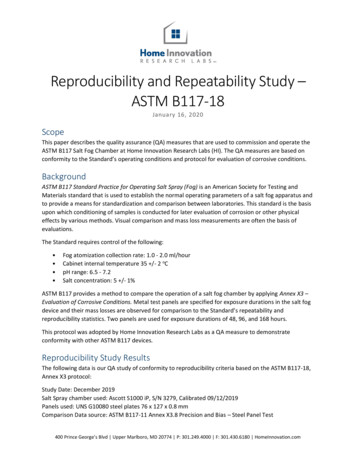
Transcription
Reproducibility and Repeatability Study –ASTM B117-18January 16, 2020ScopeThis paper describes the quality assurance (QA) measures that are used to commission and operate theASTM B117 Salt Fog Chamber at Home Innovation Research Labs (HI). The QA measures are based onconformity to the Standard’s operating conditions and protocol for evaluation of corrosive conditions.BackgroundASTM B117 Standard Practice for Operating Salt Spray (Fog) is an American Society for Testing andMaterials standard that is used to establish the normal operating parameters of a salt fog apparatus andto provide a means for standardization and comparison between laboratories. This standard is the basisupon which conditioning of samples is conducted for later evaluation of corrosion or other physicaleffects by various methods. Visual comparison and mass loss measurements are often the basis ofevaluations.The Standard requires control of the following: Fog atomization collection rate: 1.0 - 2.0 ml/hourCabinet internal temperature 35 /- 2 oCpH range: 6.5 - 7.2Salt concentration: 5 /- 1%ASTM B117 provides a method to compare the operation of a salt fog chamber by applying Annex X3 –Evaluation of Corrosive Conditions. Metal test panels are specified for exposure durations in the salt fogdevice and their mass losses are observed for comparison to the Standard’s repeatability andreproducibility statistics. Two panels are used for exposure durations of 48, 96, and 168 hours.This protocol was adopted by Home Innovation Research Labs as a QA measure to demonstrateconformity with other ASTM B117 devices.Reproducibility Study ResultsThe following data is our QA study of conformity to reproducibility criteria based on the ASTM B117-18,Annex X3 protocol:Study Date: December 2019Salt Spray chamber used: Ascott S1000 iP, S/N 3279, Calibrated 09/12/2019Panels used: UNS G10080 steel plates 76 x 127 x 0.8 mmComparison Data source: ASTM B117-11 Annex X3.8 Precision and Bias – Steel Panel Test400 Prince George’s Blvd Upper Marlboro, MD 20774 P: 301.249.4000 F: 301.430.6180 HomeInnovation.com
Table 1. ASTM Reproducibility Study (QP1 Panel Set)Time(h)4896168ASTMAverageMass Loss (g)0.81701.53472.5996ASTM SR,StandardDeviation (g)0.09470.20190.3255ASTM R(g)0.26520.56530.9114ASTM Cv,Coefficient ofVariation (%)11.5814.0212.52Table 2. HI Panel ResultsTime(h)4896168HI Panel 1Mass Loss (g)0.821.762.83HI Panel 2Mass Loss (g)0.801.592.60Table 3. ASTM vs HI Mass Loss Reproducibility ResultsTime(h)HI AverageMass Loss (g)ASTM AverageMass Loss (g)48961680.811.682.720.81701.53472.5996Passing Range(based on ASTM values,Mass R)Min (g)Max sPassTable 4. ASTM vs HI Coefficient of Variation Reproducibility ResultsTime(h)HI AverageMass Loss (g)HI SR, StandardDeviation (g)48961680.811.682.720.010.080.12HI Cv,Coefficient ofVariation (%)1.305.004.322Passing Range(based onASTM values) 11.58 14.02 12.52ResultPassPassPass
HI vs ASTM - Reproducibility Study43.5Mass Loss (g)32.5ASTM MINASTM MAX2HI1.5Linear (ASTM MIN)1Linear (ASTM MAX)0.50406080100120140160180Time of Exposure (hrs)Figure 1. HI vs ASTM – Reproducibility StudyRepeatability Study ResultsThe following data is our QA study of conformity to repeatability criteria based on the ASTM B117-18,Annex X3 protocol:Study Date: December 2019Salt Spray chamber used: Ascott S1000 iP, S/N 3279, Calibrated 09/12/2019Panels used: UNS G10080 steel plates 76 x 127 x 0.8 mmComparison Data source: ASTM B117-11 Annex X3.8 Precision and Bias - Steel Panel TestTable 5. ASTM Repeatability Study (QP1 Panel Set)Time(h)4896168ASTMAverageMass Loss (g)0.81701.53472.5996ASTM Sr,StandardDeviation (g)0.05880.10480.24983ASTM r(g)Cv, Coefficientof Variation (%)0.16460.29340.69947.207.289.61
Table 6. ASTM vs HI Mass Loss Repeatability ResultsTime(h)HI AverageMass Loss (g)ASTM AverageMass Loss (g)48961680.811.682.720.81701.53472.5996Passing Range(based on ASTM values,Mass r)Min (g)Max ssPassTable 7. ASTM vs HI Coefficient of Variation Repeatability ResultsTime(h)HI AverageMass Loss (g)48961680.811.682.72HI Sr,StandardDeviation (g)0.010.080.12HI Cv,Coefficient ofVariation (%)1.305.004.32Passing Range(based onASTM values) 7.20 7.28 9.61ResultPassPassPassHI vs ASTM - Repeatability Study3.53Mass Loss (g)2.5ASTM MIN2ASTM MAX1.5HILinear (ASTM MIN)1Linear (ASTM MAX)0.50406080100120140160Time of Exposure (hrs)Figure 2. HI vs ASTM – Repeatability Study4180
DiscussionA pair of panels were tested in accordance with the ASTM B117-18 standard. Following testing, thecollected data were analyzed to determine repeatability and reproducibility statistics in comparison tothe interlaboratory study conducted by ASTM. For the purposes of the comparison, ASTM data frommaterial QP1 was used, as that material was tested by the most laboratories. Home Innovationacceptance criteria were bounded by the results of that study.Figures 1 and 2 graphically show that repeatability and reproducibility results are well within the boundsestablished by the ASTM interlaboratory testing.ConclusionThe Home Innovation Research Lab’s results were found to be within the repeatability andreproducibility ranges provided by ASTM B117-18.5
Reproducibility and Repeatability Study - ASTM B117-18 Author: Home Innovation Research Labs Keywords: Corrosion testing, salt fog, spray fog, ASTM B117, ASTM B287, ASTM B368, ASTM G43, ASTM G85, ASTM D2247, ASTM D1735 Created Date: 1/17/2020 9:55:54 AM
